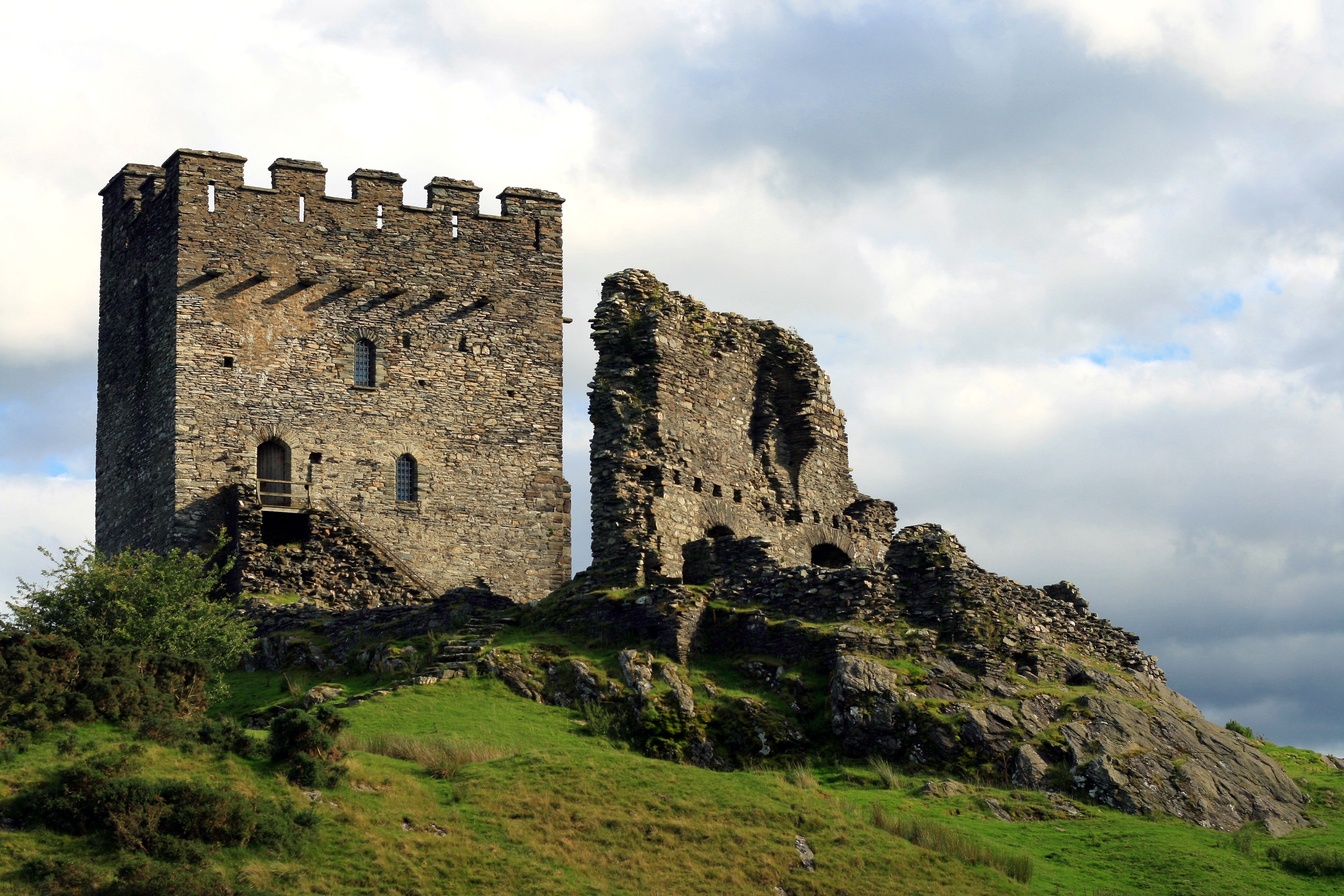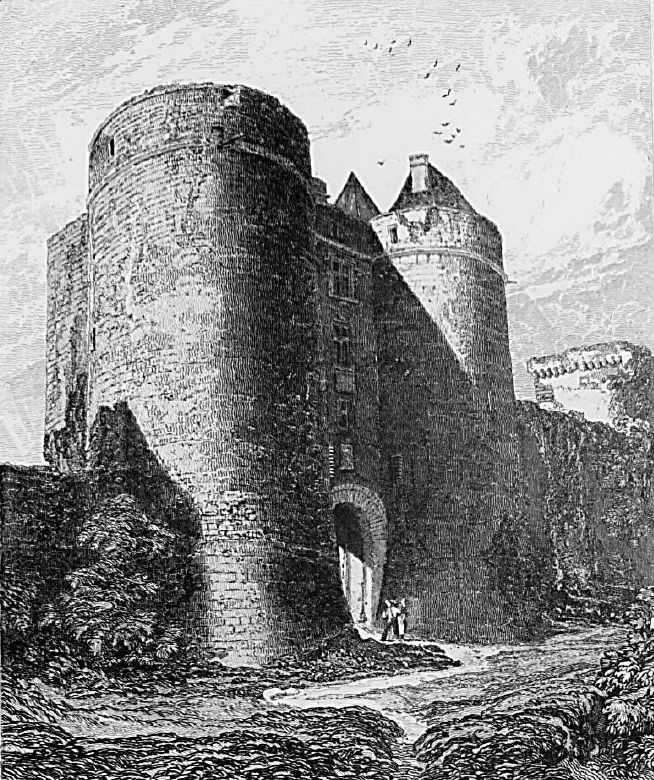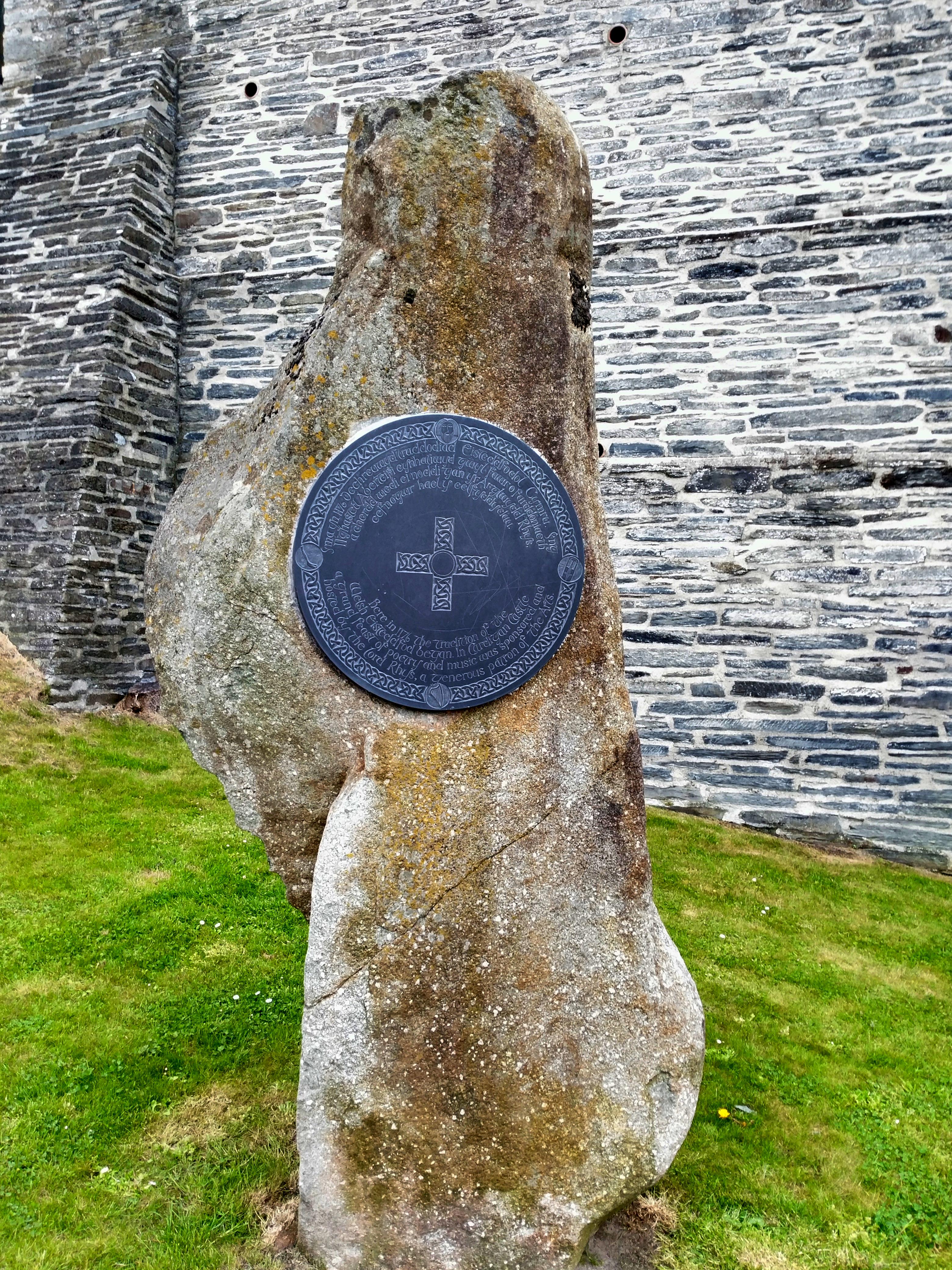|
Cardigan Castle (1128930)
Cardigan Castle ( cy, Castell Aberteifi) is a castle overlooking the River Teifi in Cardigan, Ceredigion, Wales. It is a Grade I listed building. The castle dates from the late 11th-century, though was rebuilt in 1244. Castle Green House was built inside the castle walls in the early 1800s. After falling into disrepair the castle was restored in the early 2000s and opened to the public in 2015. It is owned by Ceredigion County Council and now includes a heritage centre and open-air concert facilities. The castle's gardens are listed on the Cadw/ICOMOS Register of Parks and Gardens of Special Historic Interest in Wales. History The first motte-and-bailey castle (ca.1093) was built a mile away from the present site, probably about the time of the founding of the town by Roger de Montgomery, a Norman baron. In 1110, King Henry I of England took Cardigan from Prince Owain ap Cadwgan as a punishment, and gave the Lordship of Cardigan and the castle to Gilbert Fitz Richard. ... [...More Info...] [...Related Items...] OR: [Wikipedia] [Google] [Baidu] |
Cardigan, Ceredigion
Cardigan ( cy, Aberteifi, ) is both a town and a community in the county of Ceredigion, Wales. Positioned on the tidal reach of the River Teifi at the point where Ceredigion meets Pembrokeshire, Cardigan was the county town of the historic county of Cardiganshire. Cardigan is the second-largest town in Ceredigion. The largest town, Aberystwyth, is one of the two administrative centres; the other is Aberaeron. The settlement at Cardigan was developed around the Norman castle built in the late 11th or early 12th century. The castle was the location of the first National Eisteddfod in 1176. The town became an important port in the 18th century, but declined by the early 20th century owing to its shallow harbour. The castle underwent restoration in 2014. The population in 2001 was 4,203, reducing slightly to 4,184 at the 2011 census. Toponymy Cardigan is an anglicisation of the Welsh ' ("Ceredig's land"), the surrounding territory its Norman castle once controlled. Ceredig w ... [...More Info...] [...Related Items...] OR: [Wikipedia] [Google] [Baidu] |
Gilbert Fitz Richard
Gilbert Fitz Richard (–), 2nd feudal baron of Clare in Suffolk, and styled "de Tonbridge", was a powerful Anglo-Norman baron who was granted the Lordship of Cardigan, in Wales . Life Gilbert, born before 1066, was the second son and an heir of Richard Fitz Gilbert of Clare and Rohese Giffard. He succeeded to his father's possessions in England in 1088 when his father retired to a monastery; his brother, Roger Fitz Richard, inherited his father's lands in Normandy. That same year he, along with his brother Roger, fortified his castle at Tonbridge against the forces of William Rufus. But his castle was stormed, Gilbert was wounded and taken prisoner. However he and his brother were in attendance on king William Rufus at his death in August 1100. He was with Henry I at his Christmas court at Westminster in 1101. It has been hinted, by modern historians, that Gilbert, as a part of a baronial conspiracy, played some part in the suspicious death of William II.Frank Barlow, ''W ... [...More Info...] [...Related Items...] OR: [Wikipedia] [Google] [Baidu] |
Aberdyfi
Aberdyfi (), also known as Aberdovey ( ), is a village and community in Gwynedd, Wales, located on the northern side of the estuary of the River Dyfi. The population of the community was 878 at the 2011 census. The electoral ward had a larger population of 1,282 and includes the community of Pennal. Founded by shipbuilding, Aberdyfi is now a seaside resort with a high quality beach. The centre is on the river and seafront, around the original harbour, jetty and beach; it stretches back from the coast and up the steep hillside in the midst of typical Welsh coastal scenery of steep green hills and sheep farms. Penhelig railway station ( cy, Penhelyg) is in the eastern part of the village. Being less than from the West Midlands, the area is popular with tourists. 43.3% of houses in the village are holiday homes. The village is located within the Snowdonia National Park. In the 2011 census, 38.5% of the population of Aberdyfi ward identified themselves as Welsh (or combine ... [...More Info...] [...Related Items...] OR: [Wikipedia] [Google] [Baidu] |
Llywelyn The Great
Llywelyn the Great ( cy, Llywelyn Fawr, ; full name Llywelyn mab Iorwerth; c. 117311 April 1240) was a King of Gwynedd in north Wales and eventually " Prince of the Welsh" (in 1228) and "Prince of Wales" (in 1240). By a combination of war and diplomacy he dominated Wales for 45 years. During Llywelyn's childhood, Gwynedd was ruled by two of his uncles, who split the kingdom between them, following the death of Llywelyn's grandfather, Owain Gwynedd, in 1170. Llywelyn had a strong claim to be the legitimate ruler and began a campaign to win power at an early age. He was sole ruler of Gwynedd by 1200 and made a treaty with King John of England that year. Llywelyn's relations with John remained good for the next ten years. He married John's natural daughter Joan in 1205, and when John arrested Gwenwynwyn of Powys in 1208, Llywelyn took the opportunity to annex southern Powys. In 1210, relations deteriorated, and John invaded Gwynedd in 1211. Llywelyn was forced to seek terms and to ... [...More Info...] [...Related Items...] OR: [Wikipedia] [Google] [Baidu] |
William Marshal, 1st Earl Of Pembroke
William Marshal, 1st Earl of Pembroke (1146 or 1147 – 14 May 1219), also called William the Marshal (Norman French: ', French: '), was an Anglo-Norman soldier and statesman. He served five English kings— Henry II, his sons the "Young King" Henry, Richard I, and John, and finally John's son Henry III. Knighted in 1166, he spent his younger years as a knight errant and a successful tournament competitor; Stephen Langton eulogised him as the "best knight that ever lived." In 1189, he became the ''de facto'' earl of Pembroke through his marriage to Isabel de Clare, though the title of earl was not officially granted until 1199 during the second creation of the Pembroke earldom. In 1216, he was appointed protector for the nine-year-old Henry III, and regent of the kingdom. Before him, his father's family held a hereditary title of Marshal to the king, which by his father's time had become recognised as a chief or master Marshalcy, involving management over other Marsha ... [...More Info...] [...Related Items...] OR: [Wikipedia] [Google] [Baidu] |
John Of England
John (24 December 1166 – 19 October 1216) was King of England from 1199 until his death in 1216. He lost the Duchy of Normandy and most of his other French lands to King Philip II of France, resulting in the collapse of the Angevin Empire and contributing to the subsequent growth in power of the French Capetian dynasty during the 13th century. The baronial revolt at the end of John's reign led to the sealing of , a document considered an early step in the evolution of the constitution of the United Kingdom. John was the youngest of the four surviving sons of King Henry II of England and Duchess Eleanor of Aquitaine. He was nicknamed John Lackland because he was not expected to inherit significant lands. He became Henry's favourite child following the failed revolt of 1173–1174 by his brothers Henry the Young King, Richard, and Geoffrey against the King. John was appointed Lord of Ireland in 1177 and given lands in England and on the continent. He unsuccessfu ... [...More Info...] [...Related Items...] OR: [Wikipedia] [Google] [Baidu] |
Gruffydd Ap Rhys II
Gruffydd ap Rhys II (died 25 July 1201) was a prince of Deheubarth in south-west Wales. Lineage He was the son of Rhys ap Gruffydd (The Lord Rhys) and grandson of Gruffydd ap Rhys. Gruffydd was the eldest son of Rhys ap Gruffydd by his wife Gwenllian, daughter of Madog ap Maredudd prince of Powys. Rhys intended Gruffydd to be his main heir, and in 1189 he married Maud de Braose, the daughter of Maud de St Valery and of William de Braose. They had two sons, Rhys and Owain. Family feud In Rhys' last years a feud developed between Gruffydd and his brother Maelgwn ap Rhys, both supported by some of their other brothers. In 1189 Rhys was persuaded to imprison Maelgwn, and he was given into Gruffydd's keeping at Dinefwr. Gruffydd handed him over to his father in law, William de Braose. In 1192 Rhys secured Maelgwn's release, but by now he and Gruffydd were bitter enemies. In 1194 Maelgwn and another brother Hywel defeated their father and imprisoned him, though he was later re ... [...More Info...] [...Related Items...] OR: [Wikipedia] [Google] [Baidu] |
Maelgwn Ap Rhys
Maelgwn ap Rhys (c. 1170–1230) was prince of part of the kingdom of Deheubarth in south west Wales. Maelgwn was the son of Rhys ap Gruffydd (''The Lord Rhys'') by his wife Gwenllian ferch Madog, daughter of Madog ap Maredudd prince of Powys. He appears in the historical record for the first time helping at the siege of Tenby in 1187. In 1188 when Baldwin, Archbishop of Canterbury and Giraldus Cambrensis travelled through Wales raising men for the Third Crusade, Maelgwn is recorded as having taken the cross, though there is no record that he actually went on the crusade. Maelgwn was described as being short in stature and a turbulent character, who caused his father much trouble in his later years and maintained a lengthy feud with his brother Gruffydd. He was kept a prisoner from 1189 to 1192. In 1194 he and his brother Hywel defeated their father in battle and imprisoned him in Nevern castle, though he was later released by Hywel. Maelgwn was in exile when Rhys died in 1197. G ... [...More Info...] [...Related Items...] OR: [Wikipedia] [Google] [Baidu] |
1176 Cardigan Eisteddfod
The 1176 Cardigan eisteddfod, as it is commonly described, was a cultural tournament involving bards and musicians, held in the grounds of Cardigan Castle, Cardigan, West Wales, by the Lord Rhys ap Gruffydd. Though the term ' Eisteddfodd' was not commonly used until several centuries later, the 1176 gathering is commonly claimed to be the earliest recorded forerunner of the modern national eisteddfod event. Background Rhys ap Gruffydd became the ruler uniting the whole of Deheubarth, covering southwest Wales, in 1155. This had followed years of battles with the English King Henry II. Rhys was made Lord of Ystrad Tywi or, commonly, the Lord Rhys. There followed a period of relative peace and security. In the early 1170s Henry II sought friendship with Rhys and confirmed his leadership of Deheubarth. In 1171 Rhys rebuilt Cardigan Castle in stone, as a political and military statement, making it his chief residence. Welsh princes commonly patronised professional bards at the ... [...More Info...] [...Related Items...] OR: [Wikipedia] [Google] [Baidu] |
Rhys Ap Gruffydd
Rhys ap Gruffydd, commonly known as The Lord Rhys, in Welsh ''Yr Arglwydd Rhys'' (c. 1132 – 28 April 1197) was the ruler of the Welsh kingdom of Deheubarth in south Wales from 1155 to 1197 and native Prince of Wales. It was believed that he usually used the title "Proprietary Prince of Deheubarth" or "Prince of South Wales"; however, two documents have been discovered in which he uses the title "Prince of Wales" or "Prince of the Welsh".In a charter concerning a grant to Chertsey Abbey he used ''princeps Wall e' while in another charter dated 1184 concerning Strata Florida Abbey he used ''Walliar mprinceps''. See Pryce (2005) pp. 96–97, 168–169, 171–174. Rhys was one of the most successful and powerful Welsh leaders of the Middle Ages, and after the death of the king of Gwynedd, Owain Gwynedd in 1170, he was the dominant power in Wales. Rhys's grandfather, Rhys ap Tewdwr, was king of Deheubarth, and was killed at Brecon in 1093 by Bernard de Neufmarché. Following his ... [...More Info...] [...Related Items...] OR: [Wikipedia] [Google] [Baidu] |
Roger De Clare, 3rd Earl Of Hertford
Roger de Clare, 2nd Earl of Hertford, 5th Lord of Clare, 5th Lord of Tonbridge, 5th Lord of Cardigan (1116–1173) was a powerful Anglo-Norman noble in 12th-century England. He succeeded to the Earldom of Hertford and Honor of Clare, Tonbridge and Cardigan when his brother Gilbert died without issue. Life Roger was a son of Richard Fitz Gilbert de Clare and Alice de Gernon. In 1153, he appears with his cousin, Richard Strongbow, Earl of Pembroke, as one of the signatories to the Treaty of Wallingford, in which Stephen recognises Henry of Anjou as his successor. Roger is found signing charters at Canterbury and Dover in 1156. Next year, according to Powell, he received from Henry II a grant of whatever lands he could conquer in South Wales. This is probably only an expansion of the statement of the Welsh chronicles that in this year (about 1 June) he entered Cardigan and 'stored' the castles of Humfrey, Aberdyfi, Dineir, and Rhystud. Rhys ap Gruffydd, the prince of South Wales, ... [...More Info...] [...Related Items...] OR: [Wikipedia] [Google] [Baidu] |
Robert Fitz Martin
Robert fitz Martin ( 10?? – c. 1159) was a knight from Devon whose father, Martin de Turribus, was the first Norman Lord of Kemes, in what had previously been the Dyfed part of Deheubarth. Fitz Martin inherited the Lordship of Kemes from his father, and founded St Dogmaels Abbey c. 1118. He was the first of the FitzMartin line. His descendants continued to hold lands in England and Wales until the 14th century. Family background Robert fitz Martin, was of a Frankish noble house of Blois, the great-grandson of the bellicose Eudus II, Count of Blois. He was born some time in the late 11th century to a knight of William the Conqueror, Martin de Turribus and his wife Geva de Burci, heiress of Serlo de Burci. Martin had participated in the seizure of Rhys ap Tewdwr's lands, following the latter's refusal to acknowledge the suzerainty of William Rufus (despite having acknowledged the suzerainty of William the Conqueror), consequent attack on Worcester,''The history of Wales ... [...More Info...] [...Related Items...] OR: [Wikipedia] [Google] [Baidu] |
.jpg)





